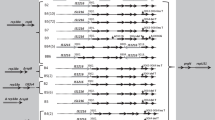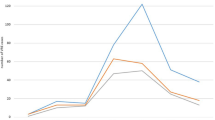Abstract
The purpose of this investigation was to control the post-outbreak prevalence of vancomycin-resistant enterococci (VRE) in the affected Kyoto region. The study period was from 2005 to 2010. Faecal samples were subjected to VRE screening, and vancomycin resistance genes were detected by polymerase chain reaction (PCR). The genotype was determined by pulsed-field gel electrophoresis (PFGE) of genomic DNA digested with SmaI and by multilocus sequence typing (MLST). A VRE control programme was established in 2006, consisting of a laboratory-based faecal VRE screening system, annual surveillance of hospital inpatients and the promotion of adequate infection control measures. vanA-Enterococcus faecium, vanB-E. faecium and vanB-E. faecalis were detected at 35, 12 and 5 hospitals, respectively. Genotype analysis revealed that all of the vancomycin-resistant E. faecium isolates obtained since 2005 belonged to ST78, and that clonally related vanB-E. faecalis of ST64 had spread to three hospitals. The rate of faecal VRE carriage among the patients enrolled in the annual surveillance increased until 2007, when it reached 24 (1.2%) of the 2,035 enrolled patients. The rate began to decrease in 2008 and, by 2010, reached a low of 4 (0.17%) of the 2,408 enrolled patients. While VRE did spread within the Kyoto region, the VRE control programme succeeded in controlling the overall VRE spread.


Similar content being viewed by others
References
Bonten MJ, Willems R, Weinstein RA (2001) Vancomycin-resistant enterococci: why are they here, and where do they come from? Lancet Infect Dis 1(5):314–325
Salgado CD, Farr BM (2003) Outcomes associated with vancomycin-resistant enterococci: a meta-analysis. Infect Control Hosp Epidemiol 24(9):690–698
Carmeli Y, Eliopoulos G, Mozaffari E, Samore M (2002) Health and economic outcomes of vancomycin-resistant enterococci. Arch Intern Med 162(19):2223–2228
Salgado CD (2008) The risk of developing a vancomycin-resistant Enterococcus bloodstream infection for colonized patients. Am J Infect Control 36(10):S175.e5–S175.e8
Werner G, Coque TM, Hammerum AM, Hope R, Hryniewicz W, Johnson A, Klare I, Kristinsson KG, Leclercq R, Lester CH, Lillie M, Novais C, Olsson-Liljequist B, Peixe LV, Sadowy E, Simonsen GS, Top J, Vuopio-Varkila J, Willems RJ, Witte W, Woodford N (2008) Emergence and spread of vancomycin resistance among enterococci in Europe. Euro Surveill 13(47):pii=19046
Lee K, Jang SJ, Lee HJ, Ryoo N, Kim M, Hong SG, Chong Y (2004) Increasing prevalence of vancomycin-resistant Enterococcus faecium, expanded-spectrum cephalosporin-resistant Klebsiella pneumoniae, and imipenem-resistant Pseudomonas aeruginosa in Korea: KONSAR study in 2001. J Korean Med Sci 19(1):8–14
Fujita N, Yoshimura M, Komori T, Tanimoto K, Ike Y (1998) First report of the isolation of high-level vancomycin-resistant Enterococcus faecium from a patient in Japan. Antimicrob Agents Chemother 42(8):2150
Infectious Diseases Surveillance Center (IDSC) (2010) Infectious diseases weekly report. National Institute of Infectious Diseases. Available online at: http://idsc.nih.go.jp/idwr/ydata/report-Ea.html. Accessed 21 July 2011
Matsumoto T, Muratani T, Okada K, Shiraishi M, Hayashida T, Oki T, Odawara M (2004) No regional spread of vancomycin-resistant enterococci with vanA or vanB in Kitakyushu, Japan. J Infect Chemother 10(6):331–334
Ieven M, Vercauteren E, Descheemaeker P, van Laer F, Goossens H (1999) Comparison of direct plating and broth enrichment culture for the detection of intestinal colonization by glycopeptide-resistant enterococci among hospitalized patients. J Clin Microbiol 37(5):1436–1440
Kariyama R, Mitsuhata R, Chow JW, Clewell DB, Kumon H (2000) Simple and reliable multiplex PCR assay for surveillance isolates of vancomycin-resistant enterococci. J Clin Microbiol 38(8):3092–3095
Turabelidze D, Kotetishvili M, Kreger A, Morris JG Jr, Sulakvelidze A (2000) Improved pulsed-field gel electrophoresis for typing vancomycin-resistant enterococci. J Clin Microbiol 38(11):4242–4245
Duck WM, Steward CD, Banerjee SN, McGowan JE Jr, Tenover FC (2003) Optimization of computer software settings improves accuracy of pulsed-field gel electrophoresis macrorestriction fragment pattern analysis. J Clin Microbiol 41(7):3035–3042
Donabedian SM, Perri MB, Abdujamilova N, Gordoncillo MJ, Naqvi A, Reyes KC, Zervos MJ, Bartlett P (2010) Characterization of vancomycin-resistant Enterococcus faecium isolated from swine in three Michigan counties. J Clin Microbiol 48(11):4156–4160
Leavis HL, Bonten MJ, Willems RJ (2006) Identification of high-risk enterococcal clonal complexes: global dispersion and antibiotic resistance. Curr Opin Microbiol 9(5):454–460
Homan WL, Tribe D, Poznanski S, Li M, Hogg G, Spalburg E, Van Embden JD, Willems RJ (2002) Multilocus sequence typing scheme for Enterococcus faecium. J Clin Microbiol 40(6):1963–1971
Muto CA, Jernigan JA, Ostrowsky BE, Richet HM, Jarvis WR, Boyce JM, Farr BM; SHEA (2003) SHEA guideline for preventing nosocomial transmission of multidrug-resistant strains of Staphylococcus aureus and Enterococcus. Infect Control Hosp Epidemiol 24(5):362–386
Siegel JD, Rhinehart E, Jackson M, Chiarello L; Healthcare Infection Control Practices Advisory Committee (2007) Management of multidrug-resistant organisms in health care settings, 2006. Am J Infect Control 35(10 Suppl 2):S165–S193
Martone WJ (1998) Spread of vancomycin-resistant enterococci: why did it happen in the United States? Infect Control Hosp Epidemiol 19(8):539–545
Bopp LH, Schoonmaker DJ, Baltch AL, Smith RP, Ritz WJ (1999) Molecular epidemiology of vancomycin-resistant enterococci from 6 hospitals in New York State. Am J Infect Control 27(5):411–417
National Nosocomial Infections Surveillance System (NNIS) (1999) National Nosocomial Infections Surveillance (NNIS) system report, data summary from January 1990–May 1999, issued June 1999. Am J Infect Control 27(6):520–532
National Nosocomial Infections Surveillance System (NNIS) (2000) National Nosocomial Infections Surveillance (NNIS) system report, data summary from January 1992–April 2000, issued June 2000. Am J Infect Control 28(6):429–448
Hsieh YC, Lee WS, Ou TY, Hsueh PR (2010) Clonal spread of CC17 vancomycin-resistant Enterococcus faecium with multilocus sequence type 78 (ST78) and a novel ST444 in Taiwan. Eur J Clin Microbiol Infect Dis 29(1):25–30
Stampone L, Del Grosso M, Boccia D, Pantosti A (2005) Clonal spread of a vancomycin-resistant Enterococcus faecium strain among bloodstream-infecting isolates in Italy. J Clin Microbiol 43(4):1575–1580
Galloway-Peña JR, Nallapareddy SR, Arias CA, Eliopoulos GM, Murray BE (2009) Analysis of clonality and antibiotic resistance among early clinical isolates of Enterococcus faecium in the United States. J Infect Dis 200(10):1566–1573
Fallico L, Boldrin C, Grossato A, Franchin E, De Canale E, Tommasini T, Parisi SG, Manganelli R, Palù G (2011) Molecular epidemiology of Enterococcus faecium isolates from an Italian hospital. Infection 39(2):127–133
Muratani T, Matsumoto T (2004) Bacterial resistance to antimicrobials in urinary isolates. Int J Antimicrob Agents 24(Suppl 1):S28–S31
Ruiz-Garbajosa P, Bonten MJ, Robinson DA, Top J, Nallapareddy SR, Torres C, Coque TM, Cantón R, Baquero F, Murray BE, del Campo R, Willems RJ (2006) Multilocus sequence typing scheme for Enterococcus faecalis reveals hospital-adapted genetic complexes in a background of high rates of recombination. J Clin Microbiol 44(6):2220–2228
Quiñones D, Kobayashi N, Nagashima S (2009) Molecular epidemiologic analysis of Enterococcus faecalis isolates in Cuba by multilocus sequence typing. Microb Drug Resist 15(4):287–293
Galloway-Peña JR, Nallapareddy SR, Arias CA, Eliopoulos GM, Murray BE (2009) Analysis of clonality and antibiotic resistance among early clinical isolates of Enterococcus faecium in the United States. J Infect Dis 200:1566–1573
Novicki TJ, Schapiro JM, Ulness BK, Sebeste A, Busse-Johnston L, Swanson KM, Swanzy SR, Leisenring W, Limaye AP (2004) Convenient selective differential broth for isolation of vancomycin-resistant Enterococcus from fecal material. J Clin Microbiol 42(4):1637–1640
Acknowledgements
We thank Kyoto City and the Kyoto Prefecture for their practical support. We also appreciate the study and manuscript advice offered by Drs. Yasuyoshi Ike, Haruyoshi Tomita and Yoshichika Arakawa.
Aki Matsushima has received research funding from the Kurozumi Medical Foundation.
Shunji Takakura has received research funding from the Japanese Ministry of Education, Culture, Sports, Science and Technology (Kiban B, 18390172).
Yoshitsugu Iinuma has received research funding from the Japanese Ministry of Health, Labour and Welfare (the Research Grant for Longevity Sciences 21A-20).
Satoshi Ichiyama has received research funding from Kyoto City and the Kyoto Prefecture.
Conflicts of interest
None of the authors have any financial relationships with the organisation that sponsored the research.
Author information
Authors and Affiliations
Corresponding author
Rights and permissions
About this article
Cite this article
Matsushima, A., Takakura, S., Yamamoto, M. et al. Regional spread and control of vancomycin-resistant Enterococcus faecium and Enterococcus faecalis in Kyoto, Japan. Eur J Clin Microbiol Infect Dis 31, 1095–1100 (2012). https://doi.org/10.1007/s10096-011-1412-x
Received:
Accepted:
Published:
Issue Date:
DOI: https://doi.org/10.1007/s10096-011-1412-x




